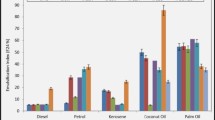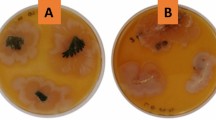Abstract
Sodium dodecyl sulphate (SDS) is a widely used surfactant constituent in detergents and cosmetics. However, its accumulation in the soil and aquatic habitats could be detrimental to their corresponding flora and fauna. Thus, its bioremediation by suitable microbes is crucial. The current study aims at evaluating the bioremediation properties of the endophytic bacterial strains isolated from the two Indian medicinal plants: Cuminum cyminum and Foeniculum vulgare. Medicinal plants are a rich source of numerous bioactive compounds having several therapeutic benefits. Thus, when it comes to the endosymbiotic microbiome thriving in them, aka the endophytic bacteria/fungi, there is a whole new field of research to explore regarding their metabolite potential and adaptive mechanisms. Initial screening was done by employing enrichment technique wherein SDS at a concentration of 1 g l–1 was the only carbon source. Out of 24 endophytic strains, 3 strains S8, S9 and R6 were detected to have SDS degrading capabilities. This was confirmed by the presence of clearance zones on the agar plate that substantiates the strain’s ability to degrade and intake of SDS. These 3 isolates and a positive control, Pseudomonas aeruginosa PAO1, were further subjected to higher concentrations of SDS ranging from 1, 2, 4, 6, 8 and 10 g l–1, to check the state of its degradation. The results were remarkable as it represented strain R6 was able to degrade higher concentration of SDS present in the medium, hence confirming that this can be used for environmental degradation of SDS. The S8 and R6 strains were identified as Pseudomona sp. based on 16 s rRNA sequencing technique.







Similar content being viewed by others
References
Furmanczyk, E. M., Kaminski, M. A., Spolnik, G., Sojka, M., Danikiewicz, W., Dziembowski, A., Lipinski, L., &Sobczak, A. (2017). Isolation and Characterization of Pseudomonas spp. Strains That Efficiently Decompose Sodium Dodecyl Sulfate. Frontiers in Microbiology, 8, 1872. https://doi.org/10.3389/fmicb.2017.01872
Panasia, G., Oetermann, S., Steinbüchel, A., & Philipp, B. (2019). Sulfate Ester Detergent Degradation in Pseudomonas aeruginosa Is Subject to both Positive and Negative Regulation. Applied and Environmental Microbiology, 85(23). https://doi.org/10.1128/AEM.01352-19
Klebensberger J, Rui O, Fritz E, Schink B, Philipp B (2006) Cell aggregation of Pseudomonas aeruginosa strain PAO1 as an energy-dependent stress response during growth with sodium dodecyl sulfate. Arch Microbiol 185(6):417–427. https://doi.org/10.1007/s00203-006-0111-y
Sofowora, A., Ogunbodede, E., &Onayade, A. (2013). The role and place of medicinal plants in the strategies for disease prevention. African Journal of Traditional, Complementary and Alternative Medicines, 10(5). https://doi.org/10.4314/ajtcam.v10i5.2
McGuinness M, Dowling D (2009) Plant-Associated Bacterial Degradation of Toxic Organic Compounds in Soil. International Journal Of Environmental Research And Public Health 6(8):2226–2247. https://doi.org/10.3390/ijerph6082226
Germaine KJ, Keogh E, Ryan D, Dowling DN (2009) Bacterial endophyte-mediated naphthalene phytoprotection and phytoremediation. FEMS Microbiol Lett 296(2):226–234. https://doi.org/10.1111/j.1574-6968.2009.01637.x
Larran S, Perelló A, Simón M, Moreno V (2002) Isolation and analysis of endophytic microorganisms in wheat (Triticum aestivum L.) leaves. World J Microbiol Biotechnol 18:683–686
Ramalashmi K, Prasanna Vengatesh K, Magesh K, Sanjana R, Siril Joe S, Ravibalan K (2018) A potential surface sterilization technique and culture media for the isolation of endophytic bacteria from Acalypha indica and its antibacterial activity. Plantsjournal Com 6(1):181–184
Qin S, Xing K, Jiang J, Xu L, Li W (2010) Biodiversity, bioactive natural products and biotechnological potential of plant-associated endophytic actinobacteria. Applied Microbiology And Biotechnology 89(3):457–473. https://doi.org/10.1007/s00253-010-2923-6
Altschul SF, Gish W, Miller W, Myers EW, Lipman DJ (1990) Basic local alignment search tool. J Mol Biol 215(3):403–410. https://doi.org/10.1016/S0022-2836(05)80360-2
Lemoine, F., Correia, D., Lefort, V., Doppelt-Azeroual, O., Mareuil, F., Cohen-Boulakia, S., &Gascuel, O. (2019). NGPhylogeny.fr: new generation phylogenetic services for non-specialists. Nucleic Acids Research, 47(W1), W260–W265. https://doi.org/10.1093/nar/gkz303
Shahbazi, R., Kasra-Kermanshahi, R., Gharavi, S., Moosavi-Nejad, Z., &Borzooee, F. (2013). Screening of SDS-degrading bacteria from car wash wastewater and study of the alkylsulfatase enzyme activity. Iranian Journal of Microbiology, 5(2), 153–158. http://www.ncbi.nlm.nih.gov/pubmed/23825734
Razzaq, A., Shamsi, S., Ali, A., Ali, Q., Sajjad, M., Malik, A., & Ashraf, M. (2019). Microbial Proteases Applications. Frontiers in Bioengineering and Biotechnology, 7. http://doi.org/:https://doi.org/10.3389/fbioe.2019.00110
Bergkessel M, Delavaine L (2021) Diversity in Starvation Survival Strategies and Outcomes among Heterotrophic Proteobacteria. Microbial Physiology 31(2):146–162. https://doi.org/10.1159/000516215
Watson S, Clements M, Foster S (1998) Characterization of the Starvation-Survival Response of Staphylococcus aureus. J Bacteriol 180(7):1750–1758. https://doi.org/10.1128/jb.180.7.1750-1758.1998
Schleheck D, Barraud N, Klebensberger J, Webb JS, McDougald D (2009) Pseudomonas aeruginosa PAO1 Preferentially Grows as Aggregates in Liquid Batch Cultures and Disperses upon Starvation. PLoS ONE 4(5):e5513. https://doi.org/10.1371/journal.pone.0005513
Germaine KJ, Keogh E, Ryan D, Dowling DN (2009) Bacterial endophyte mediated naphthalene phytoprotection and phytoremediation. FEMS Microbiol Lett 296(2):226–234. https://doi.org/10.1111/j.1574-6968.2009.01637.x
Yousaf S, Afzal M, Reichenauer TG, Brady CL, Sessitsch A (2011) Hydrocarbon degradation, plant colonization and gene expression of alkane degradation genes by endophytic Enterobacter ludwigii strains. Environ Pollut 159(10):2675–2683. https://doi.org/10.1016/j.envpol.2011.05.031
Acknowledgements
This study was funded by PES University under the student project category.
Author information
Authors and Affiliations
Contributions
All authors contributed to the study conception and design. Material preparation, data collection and analysis were performed by all the authors. The first draft of the manuscript was written by Vaishali S, Siddharth S and Keshav Sherikar. The final draft and editing was done by Dr. Sasmita Sabat. All the authors read and approve the content of the manuscript and approved for publication.
Corresponding author
Ethics declarations
Conflict of interest
The authors declare that they have no conflict of interest.
Additional information
Publisher's Note
Springer Nature remains neutral with regard to jurisdictional claims in published maps and institutional affiliations.
Significance Statement
The study focus on the role of endophytes present in symbiotic association with the plant found to be effective and help in reduction of toxic detergents present in the soil to less toxic form. This investigation is able to provide improved and convenient bioremediation technique in the treatment of SDS.
Rights and permissions
About this article
Cite this article
S, V., Siddharth, S., Sherikar, K. et al. Endophytic Bacteria Isolated from Indian Spices: An Efficient Bioremediation Agent for the Degradation of Sodium Dodecyl Sulphate. Proc. Natl. Acad. Sci., India, Sect. B Biol. Sci. 93, 195–203 (2023). https://doi.org/10.1007/s40011-022-01412-9
Received:
Revised:
Accepted:
Published:
Issue Date:
DOI: https://doi.org/10.1007/s40011-022-01412-9




